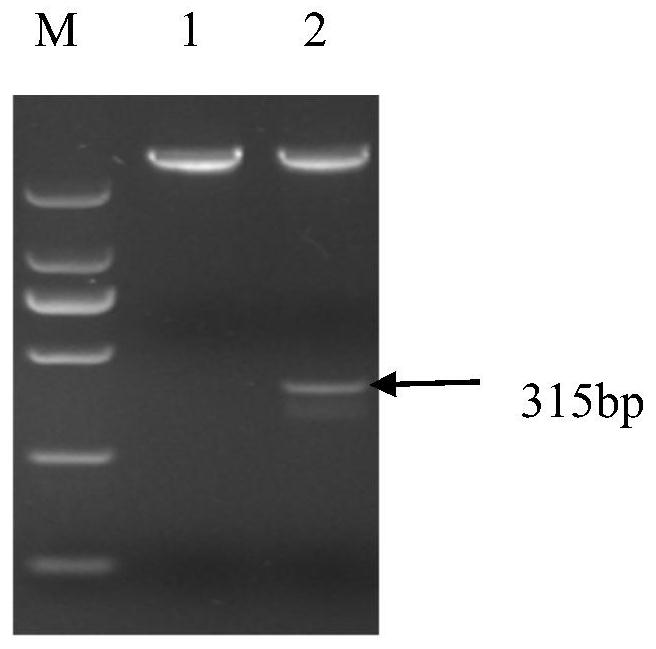Construction of cell strain capable of stably expressing porcine circovirus type 2 ORF3 protein and application thereof
A porcine circovirus, a technology for stable expression, applied in the field of biotechnology detection
- Summary
- Abstract
- Description
- Claims
- Application Information
AI Technical Summary
Problems solved by technology
Method used
Image
Examples
Embodiment 1
[0024] Example 1 PCV2 ORF3 Gene Amplification
[0025] 1. PCR amplification of PCV2 ORF3 gene According to the PCV2 ORF3 gene sequence in NCBI (No: AY686763), use the software primer 5 to design the specific primers PCV2 ORF3 gene PCV2 ORF3-F and PCV2 ORF3-R, and add restriction sites NheI and BamH I, for the convenience of subsequent identification, a Flag tag sequence was added to the 3' end of the gene (see the list of SEQ ID3 for the sequence). Use the DNA of PK-15 cells infected with PCV2 as a template for PCR amplification. The PCR amplification system is: template 1 μl, PrimerF (10 μM) 1 μL, Primer R (10 μM) 1 μl, PCR Mix (2×) 25 μl, ddH2O up to 50 μl; PCR reaction program: pre-denaturation at 95°C for 5 min, denaturation at 95°C for 30 s, annealing at 55°C for 30 s, extension at 72°C for 45 s, a total of 35 cycles, and a final extension at 72°C for 10 min. After the PCR, 10 μL of the amplified product was electrophoresed on a 1% agarose gel, and the DNA was recovered ...
Embodiment 2
[0026] Example 2 Construction of recombinant expression vector pLVZG-CMV-copGFP-Puro
[0027] Construction of recombinant lentiviral expression plasmid: The PCR product obtained in Example 1 and pLVZG-CMV-copGFP-Puro were digested with NheI and BamHI respectively, and the enzyme digestion system was placed in a water bath at 37°C overnight, electrophoresis, and the correct target band Perform gel recovery. The enzyme digestion system is as follows: ddH2O: 11ul; NheI: 1.5ul; BamHI: 1.5ul; DNA: 1ul (1ug / ul); Enzyme Buffer: 5ul; total system: 20ul, temperature 37°C, reaction time: 30min. React at 16°C for 24 hours to construct a recombinant lentiviral expression plasmid, and construct a recombinant lentiviral expression plasmid pLVZG-CMV-ORF3-copGFP-Puro (see figure 1). The recombinant vector was identified by agarose gel electrophoresis after NheI and BamHI double digestion, and the 8kb vector band and the 305bp target band were observed, while the pLVZG-CMV-copGFP-Puro empty ...
Embodiment 3
[0028] Example 3 Obtaining of recombinant lentivirus CMV-ORF3-copGFP-Puro
[0029] 1. Lentiviral Packaging
[0030] 293T cells were planted in a 10 cm culture dish, placed in an incubator at 37°C and 5% CO2, and the cell confluence reached about 80% after 12 hours of passage. Plasmid cotransfection system: pMDLg / pRRE 6 μg, pRSV-Rev 3 μg, pMD2.G 2 μg, shuttle plasmid 9 μg, Lipo3000 40 μL. 1 h before transfection, the medium containing 10% FBS without double antibody was replaced; 6 h after transfection, the medium containing 10% FBS was replaced with fresh medium. 48 hours after transfection, the cell supernatant was collected, and fresh cell culture medium was appropriately supplemented according to the cell growth status, and the cell supernatant was collected again at 72 hours; the collected cell supernatant (DMEM culture medium) was filtered with a 0.45 μm filter, Store at 4°C for later use;
[0031] 2. Virus Concentration and Purification
[0032] Centrifuge the collec...
PUM
 Login to View More
Login to View More Abstract
Description
Claims
Application Information
 Login to View More
Login to View More - R&D
- Intellectual Property
- Life Sciences
- Materials
- Tech Scout
- Unparalleled Data Quality
- Higher Quality Content
- 60% Fewer Hallucinations
Browse by: Latest US Patents, China's latest patents, Technical Efficacy Thesaurus, Application Domain, Technology Topic, Popular Technical Reports.
© 2025 PatSnap. All rights reserved.Legal|Privacy policy|Modern Slavery Act Transparency Statement|Sitemap|About US| Contact US: help@patsnap.com



